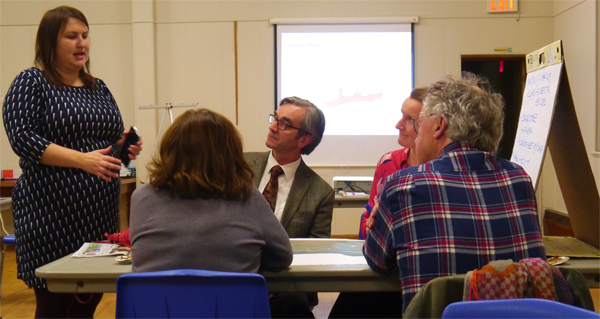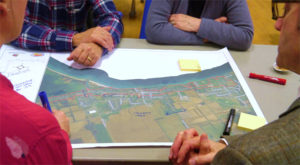Heritage Conservation District designation discussed for Wellington’s core
Administrator | Dec 03, 2019 | Comments 0

Cristal Laanstra, Planning Coordinator for the municipality, (centre): lead consultant Carl Bray of Bray Heritage, in discussion with members of the public.
Story and photos by Sharon Harrison
The municipality held an informal public consultation last week to provide further information about a study surrounding the conservation and enhancement of the village of Wellington.
The Wellington Heritage Conservation District (HCD) Study, launched last month by the municipality, is expected to take a year to complete. The study will affect Wellington’s urban centre and is designed to establish and assess whether Wellington meets the requirements of a HCD designation under the Ontario Heritage Act.
It was noted that an area of Picton’s Main Street received a HCD designation in 2013.
Wellington Town Hall saw only a handful of people attend the well-prepared meeting which included a slideshow presentation, an interactive element and informal discussion.
Lead consultant, Carl Bray, of Bray Heritage in Kingston, hosted, and will lead the study. He will be working with architect Lindsay Reid, of Branch Architecture of Picton, and Marcus Letoureau, of Letoureau Heritage Consulting Inc. of Kingston.
Bray said the evening was about introducing the public to the whole study process, but also to hear thoughts and receive comments.
 The heritage planning consultants are hoping to receive feedback and ideas for conserving and enhancing the key parts of the village’s character, which may include revising the proposed designation boundary, and so on.
The heritage planning consultants are hoping to receive feedback and ideas for conserving and enhancing the key parts of the village’s character, which may include revising the proposed designation boundary, and so on.
Public workshops, focus groups and interviews with individuals with interest or knowledge, are expected to be conducted by the consultants during the period of the study.
Bray said they also have a notional advisory committee which Hillier councillor Ernie Margetson (in attendance) had helped put together.
“How you would define the characteristic elements of the village that merit conservation?” began Bray. He explained that mostly those are places such as buildings and landscapes, but also traditions, such as Pumpkinfest, some of the uses of some of the spaces, such as the beach and the school.
Bray noted that for many years the village relied on industry.
“Is industry one of the defining characteristics of the village still, and should it be in the future?” Those are some of the things a Heritage Conservation District Study can bring forward he said.
The informative and interesting meeting was a fascinating history lesson, as Bray delved briefly into the Loyalist and pre-Loyalist periods, but also what role Indigenous peoples may have played in Wellington’s earliest history and formation.
He described how Wellington grew up with distinct areas of industry near to the waterfront, where there were two wharfs as well as windmill by the shoreline. He also spoke to the original community, later communities, and phases of industrial growth, as well as the emergence of summer homes.
Bray said a lot of questions come up around what the point of designation is.
“Designation under the Heritage Act is a very effective tool; it’s one of the best tools any municipality can have,” he said.
“In some ways, it deals with risk management,” said Bray. “If you invest in a property, you are going to be fairly confident that what’s going on around you is going to be similar in terms of caring for the setting and managing the types of change that happens. But really, it’s about long-term stewardship.”
He explained that it’s about enhancement and conservation of where you live. “And bringing that notion amongst your neighbours, and quantifying it.” Bray said provincial legislation allows municipalities to do that.
He said when discussing values and what’s importance about a place, inevitably it seems to be very subjective.
“You can’t quantify it in numbers,” he said. “It also means people don’t have a lot of clarity about what they can and can’t do on a particular piece of property, so the more you can clarify that through definitions, through clear policies and through a nested set of guidelines, it gives you good options about what you can do within the overall plan. Those are the sorts of things you get out of a conservation district.”
He explained that a conservation district is not just about pretty buildings, but is about the whole context.
“Rather than getting fixated on the architectural details of a particular building, it is what is the streetscape like, and more to the point, how has the community evolved over time and what’s still important from some of the early periods, such as the relationship to water, agricultural lands, etc.”
Wellington isn’t like other places; it has a distinct character Bray said.
He said the idea is to chart the development of the community through buildings, where he noted there are representative examples decade-by-decade.
“When we are talking about buildings it doesn’t mean they all have to be architectural masterpieces.” He noted how lucky the village is to have Tara Hall, but also the little working cottages, the little bits of industrial past, the humble stuff down by the waterfront, outbuildings and little barns. “They are all part of the story; they are all important ways of understanding the character of the community.”
Bray explained that it was also about buildings in setting, prominent views of the lake, also views of the countryside, for example Consecon Street, providing a feeling of being connected back to the land, and public spaces.
He noted the wonderful corridor of trees along Wellington’s Main Street, but also along other residential streets, such as Consecon Street, describing them as areas bracketed by natural features.
“We have linear cultural landscapes, such as the shoreline, the former rail line, Lane Creek, which used to have a mill pond where the brew pub is now, and where the Drake is, that was industrial built around the creek that still exists.”
The study area was defined in the Secondary Plan which is the village core along the Main Street noted Bray.
“We have made some changes to that from suggestions based on the research we have done so far.”
The display map shows an area stretching from the LCBO and Wellington on the Lake to the west, just past Tim Horton’s to the east, including streets such as Consecon Street, as well as the entire school property.
Bray said they have two main goals.
Does the study area merit designation as a heritage district, and why?; and second, what is the boundary?
He said their task is to go property-by-property to conduct a very preliminary inventory and evaluation of each property and cross-reference it to what is already known in the archive. They also will create a chronology of the development of the community, to figure out what the common elements are throughout.
He noted how they have been inundated with information through various sources.
A question and answer segment followed.
One audience member asked what power the heritage designation would have, if passed, and what does it mean.
Bray said the legislation allows council to control development to the extent of things like demolition. He said while it does include minor maintenance, it doesn’t affect things like what colour to paint your front door.
“It is really controlling the rate of change and the type of change that happens,” said Bray. “It essentially regulates what one can see from the roadway.”
Another question raised involved the school property as an audience member asked if the school was sold and another built, would a heritage designation prevent demolition of the property.
Bray said it wouldn’t preclude any redevelopment of the site, but it would preclude demolition. “The study would define the property as one of the key characteristics of the village,” he said.
Next steps will include Bray Heritage producing a draft report, followed by a final public meeting, before the final report goes to council.
“We started the project in late September, we are looking to have a draft final report early in the new year, and we would present the final report, probably May 2020.” The final report would then go council and if council adopts the report, it would go to the next phase which is the plan where you write the policies and the guidelines noted Bray.
The municipality’s contact for the study is project manager Cristal Laanstra, Planning Coordinator, Policy, who can be reached at 613-476-2148, extension 2027, or by email at claanstra@pecounty.on.ca. Further information can be found at the municipality’s website: http://bit.ly/WellingtonHCD.
Filed Under: Local News
About the Author:


































